Jaewon Yang
OmniSage: Large Scale, Multi-Entity Heterogeneous Graph Representation Learning
May 01, 2025Abstract:Representation learning, a task of learning latent vectors to represent entities, is a key task in improving search and recommender systems in web applications. Various representation learning methods have been developed, including graph-based approaches for relationships among entities, sequence-based methods for capturing the temporal evolution of user activities, and content-based models for leveraging text and visual content. However, the development of a unifying framework that integrates these diverse techniques to support multiple applications remains a significant challenge. This paper presents OmniSage, a large-scale representation framework that learns universal representations for a variety of applications at Pinterest. OmniSage integrates graph neural networks with content-based models and user sequence models by employing multiple contrastive learning tasks to effectively process graph data, user sequence data, and content signals. To support the training and inference of OmniSage, we developed an efficient infrastructure capable of supporting Pinterest graphs with billions of nodes. The universal representations generated by OmniSage have significantly enhanced user experiences on Pinterest, leading to an approximate 2.5% increase in sitewide repins (saves) across five applications. This paper highlights the impact of unifying representation learning methods, and we will open source the OmniSage code by the time of publication.
PinRec: Outcome-Conditioned, Multi-Token Generative Retrieval for Industry-Scale Recommendation Systems
Apr 09, 2025Abstract:Generative retrieval methods utilize generative sequential modeling techniques, such as transformers, to generate candidate items for recommender systems. These methods have demonstrated promising results in academic benchmarks, surpassing traditional retrieval models like two-tower architectures. However, current generative retrieval methods lack the scalability required for industrial recommender systems, and they are insufficiently flexible to satisfy the multiple metric requirements of modern systems. This paper introduces PinRec, a novel generative retrieval model developed for applications at Pinterest. PinRec utilizes outcome-conditioned generation, enabling modelers to specify how to balance various outcome metrics, such as the number of saves and clicks, to effectively align with business goals and user exploration. Additionally, PinRec incorporates multi-token generation to enhance output diversity while optimizing generation. Our experiments demonstrate that PinRec can successfully balance performance, diversity, and efficiency, delivering a significant positive impact to users using generative models. This paper marks a significant milestone in generative retrieval, as it presents, to our knowledge, the first rigorous study on implementing generative retrieval at the scale of Pinterest.
InteractRank: Personalized Web-Scale Search Pre-Ranking with Cross Interaction Features
Apr 09, 2025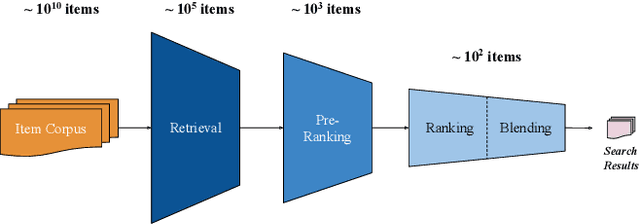

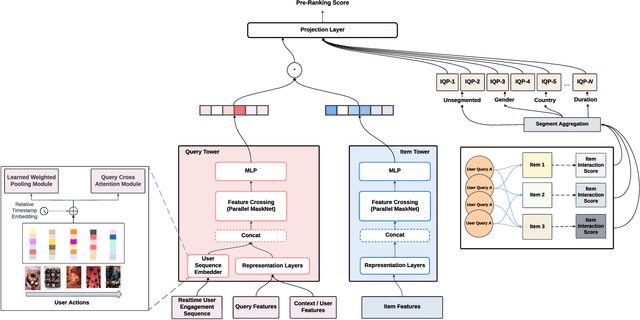

Abstract:Modern search systems use a multi-stage architecture to deliver personalized results efficiently. Key stages include retrieval, pre-ranking, full ranking, and blending, which refine billions of items to top selections. The pre-ranking stage, vital for scoring and filtering hundreds of thousands of items down to a few thousand, typically relies on two tower models due to their computational efficiency, despite often lacking in capturing complex interactions. While query-item cross interaction features are paramount for full ranking, integrating them into pre-ranking models presents efficiency-related challenges. In this paper, we introduce InteractRank, a novel two tower pre-ranking model with robust cross interaction features used at Pinterest. By incorporating historical user engagement-based query-item interactions in the scoring function along with the two tower dot product, InteractRank significantly boosts pre-ranking performance with minimal latency and computation costs. In real-world A/B experiments at Pinterest, InteractRank improves the online engagement metric by 6.5% over a BM25 baseline and by 3.7% over a vanilla two tower baseline. We also highlight other components of InteractRank, like real-time user-sequence modeling, and analyze their contributions through offline ablation studies. The code for InteractRank is available at https://github.com/pinterest/atg-research/tree/main/InteractRank.
FairSample: Training Fair and Accurate Graph Convolutional Neural Networks Efficiently
Jan 26, 2024



Abstract:Fairness in Graph Convolutional Neural Networks (GCNs) becomes a more and more important concern as GCNs are adopted in many crucial applications. Societal biases against sensitive groups may exist in many real world graphs. GCNs trained on those graphs may be vulnerable to being affected by such biases. In this paper, we adopt the well-known fairness notion of demographic parity and tackle the challenge of training fair and accurate GCNs efficiently. We present an in-depth analysis on how graph structure bias, node attribute bias, and model parameters may affect the demographic parity of GCNs. Our insights lead to FairSample, a framework that jointly mitigates the three types of biases. We employ two intuitive strategies to rectify graph structures. First, we inject edges across nodes that are in different sensitive groups but similar in node features. Second, to enhance model fairness and retain model quality, we develop a learnable neighbor sampling policy using reinforcement learning. To address the bias in node features and model parameters, FairSample is complemented by a regularization objective to optimize fairness.
Large Language Models for Social Networks: Applications, Challenges, and Solutions
Jan 04, 2024Abstract:Large Language Models (LLMs) are transforming the way people generate, explore, and engage with content. We study how we can develop LLM applications for online social networks. Despite LLMs' successes in other domains, it is challenging to develop LLM-based products for social networks for numerous reasons, and it has been relatively under-reported in the research community. We categorize LLM applications for social networks into three categories. First is knowledge tasks where users want to find new knowledge and information, such as search and question-answering. Second is entertainment tasks where users want to consume interesting content, such as getting entertaining notification content. Third is foundational tasks that need to be done to moderate and operate the social networks, such as content annotation and LLM monitoring. For each task, we share the challenges we found, solutions we developed, and lessons we learned. To the best of our knowledge, this is the first comprehensive paper about developing LLM applications for social networks.
Let AI Entertain You: Increasing User Engagement with Generative AI and Rejection Sampling
Dec 16, 2023Abstract:While generative AI excels in content generation, it does not always increase user engagement. This can be attributed to two main factors. First, generative AI generates content without incorporating explicit or implicit feedback about user interactions. Even if the generated content seems to be more informative or well-written, it does not necessarily lead to an increase in user activities, such as clicks. Second, there is a concern with the quality of the content generative AI produces, which often lacks the distinctiveness and authenticity that human-created content possesses. These two factors can lead to content that fails to meet specific needs and preferences of users, ultimately reducing its potential to be engaging. This paper presents a generic framework of how to improve user engagement with generative AI by leveraging user feedback. Our solutions employ rejection sampling, a technique used in reinforcement learning, to boost engagement metrics. We leveraged the framework in the context of email notification subject lines generation for an online social network, and achieved significant engagement metric lift including +1% Session and +0.4% Weekly Active Users. We believe our work offers a universal framework that enhances user engagement with generative AI, particularly when standard generative AI reaches its limits in terms of enhancing content to be more captivating. To the best of our knowledge, this represents an early milestone in the industry's successful use of generative AI to enhance user engagement.
Deep Job Understanding at LinkedIn
May 29, 2020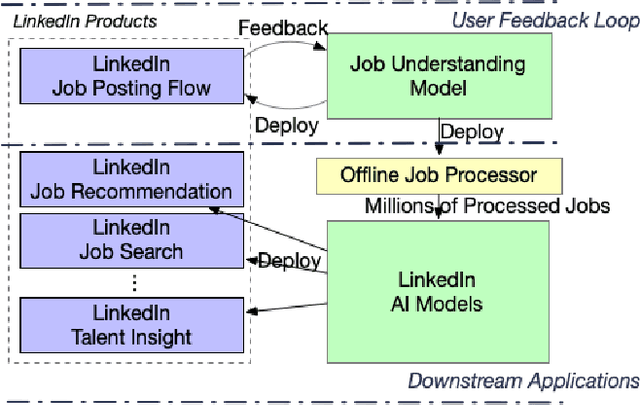
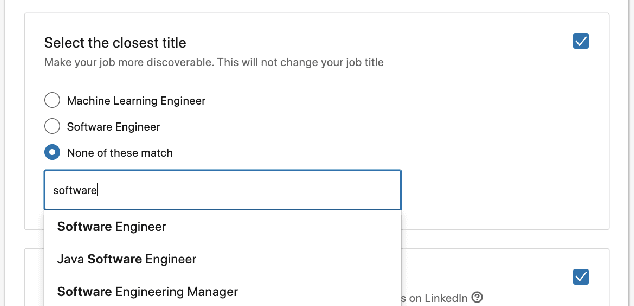
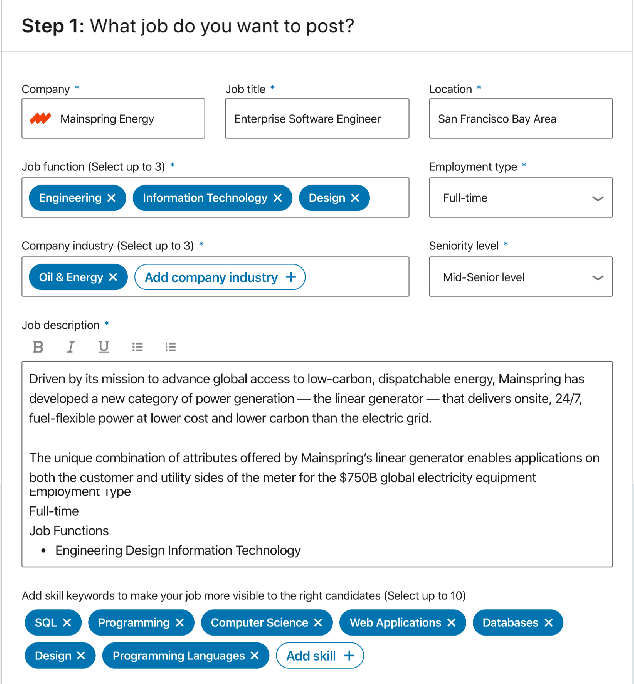
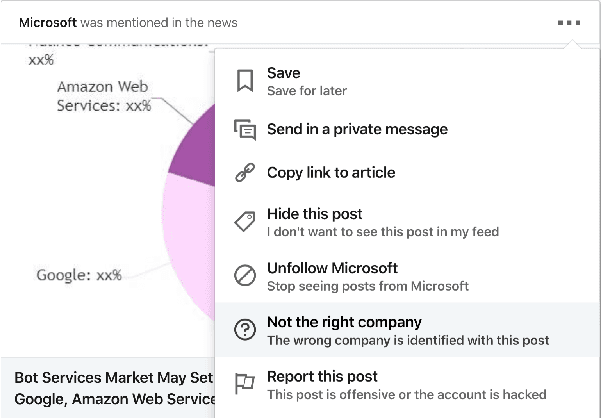
Abstract:As the world's largest professional network, LinkedIn wants to create economic opportunity for everyone in the global workforce. One of its most critical missions is matching jobs with processionals. Improving job targeting accuracy and hire efficiency align with LinkedIn's Member First Motto. To achieve those goals, we need to understand unstructured job postings with noisy information. We applied deep transfer learning to create domain-specific job understanding models. After this, jobs are represented by professional entities, including titles, skills, companies, and assessment questions. To continuously improve LinkedIn's job understanding ability, we designed an expert feedback loop where we integrated job understanding models into LinkedIn's products to collect job posters' feedback. In this demonstration, we present LinkedIn's job posting flow and demonstrate how the integrated deep job understanding work improves job posters' satisfaction and provides significant metric lifts in LinkedIn's job recommendation system.
Learning to Ask Screening Questions for Job Postings
Apr 30, 2020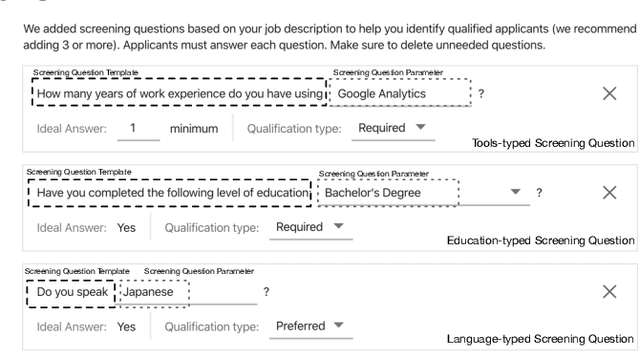


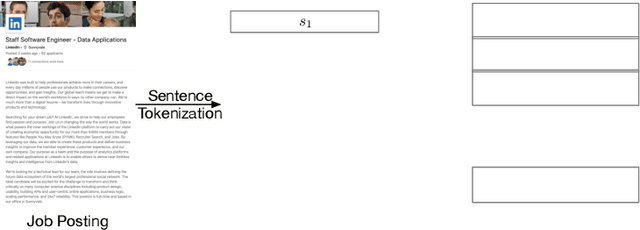
Abstract:At LinkedIn, we want to create economic opportunity for everyone in the global workforce. A critical aspect of this goal is matching jobs with qualified applicants. To improve hiring efficiency and reduce the need to manually screening each applicant, we develop a new product where recruiters can ask screening questions online so that they can filter qualified candidates easily. To add screening questions to all $20$M active jobs at LinkedIn, we propose a new task that aims to automatically generate screening questions for a given job posting. To solve the task of generating screening questions, we develop a two-stage deep learning model called Job2Questions, where we apply a deep learning model to detect intent from the text description, and then rank the detected intents by their importance based on other contextual features. Since this is a new product with no historical data, we employ deep transfer learning to train complex models with limited training data. We launched the screening question product and our AI models to LinkedIn users and observed significant impact in the job marketplace. During our online A/B test, we observed $+53.10\%$ screening question suggestion acceptance rate, $+22.17\%$ job coverage, $+190\%$ recruiter-applicant interaction, and $+11$ Net Promoter Score. In sum, the deployed Job2Questions model helps recruiters to find qualified applicants and job seekers to find jobs they are qualified for.
Joint Correction of Attenuation and Scatter Using Deep Convolutional Neural Networks (DCNN) for Time-of-Flight PET
Nov 28, 2018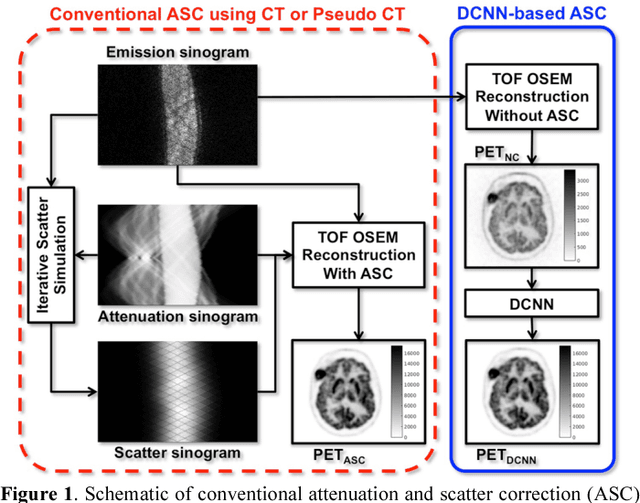

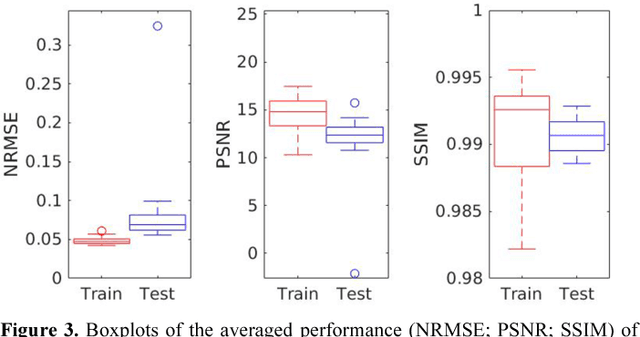
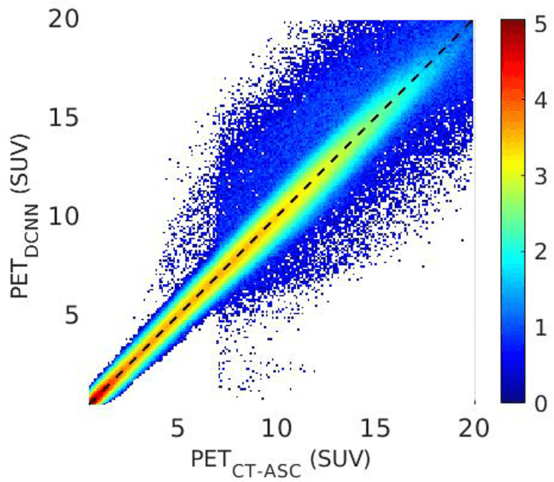
Abstract:Deep convolutional neural networks (DCNN) have demonstrated its capability to convert MR image to pseudo CT for PET attenuation correction in PET/MRI. Conventionally, attenuated events are corrected in sinogram space using attenuation maps derived from CT or MR-derived pseudo CT. Separately, scattered events are iteratively estimated by a 3D model-based simulation using down-sampled attenuation and emission sinograms. However, no studies have investigated joint correction of attenuation and scatter using DCNN in image space. Therefore, we aim to develop and optimize a DCNN model for attenuation and scatter correction (ASC) simultaneously in PET image space without additional anatomical imaging or time-consuming iterative scatter simulation. For the first time, we demonstrated the feasibility of directly producing PET images corrected for attenuation and scatter using DCNN (PET-DCNN) from noncorrected PET (PET-NC) images.
Attenuation correction for brain PET imaging using deep neural network based on dixon and ZTE MR images
May 24, 2018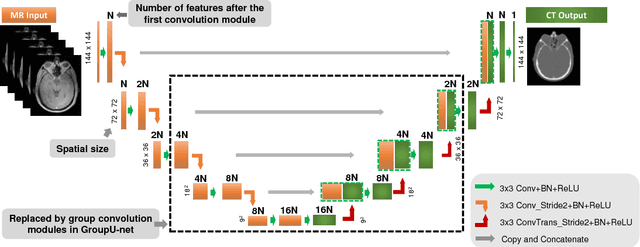

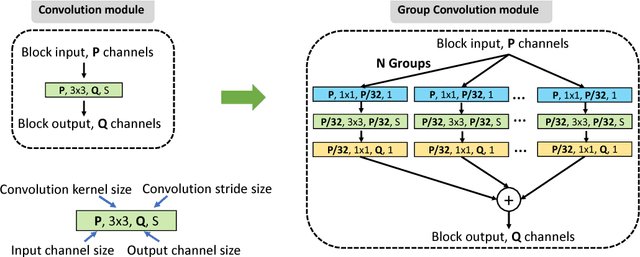

Abstract:Positron Emission Tomography (PET) is a functional imaging modality widely used in neuroscience studies. To obtain meaningful quantitative results from PET images, attenuation correction is necessary during image reconstruction. For PET/MR hybrid systems, PET attenuation is challenging as Magnetic Resonance (MR) images do not reflect attenuation coefficients directly. To address this issue, we present deep neural network methods to derive the continuous attenuation coefficients for brain PET imaging from MR images. With only Dixon MR images as the network input, the existing U-net structure was adopted and analysis using forty patient data sets shows it is superior than other Dixon based methods. When both Dixon and zero echo time (ZTE) images are available, we have proposed a modified U-net structure, named GroupU-net, to efficiently make use of both Dixon and ZTE information through group convolution modules when the network goes deeper. Quantitative analysis based on fourteen real patient data sets demonstrates that both network approaches can perform better than the standard methods, and the proposed network structure can further reduce the PET quantification error compared to the U-net structure.
 Add to Chrome
Add to Chrome Add to Firefox
Add to Firefox Add to Edge
Add to Edge